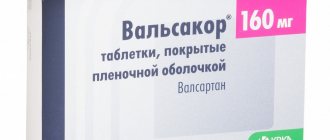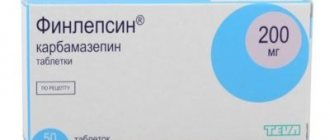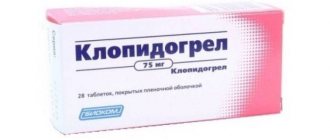Quetiapine - medical use
In accordance with the instructions that you receive when purchasing quetiapine at the pharmacy, the medicine is prescribed twice a day. Food intake does not affect its bioavailability. It is well absorbed and actively metabolized regardless of whether the drug is taken with or outside meals.
Quetiapine and its analogues are used to treat
- Acute and chronic psychoses;
- Schizoaffective disorders;
- Depressive spectrum disorders;
- Bipolar affective disorder;
- Borderline states: panic attacks, obsessive-phobic, anxious, hypochondriacal personality disorders.
The drug quetiapine is indicated for apathy, abulia, and autism. It helps improve the cognitive activity of the brain: increases concentration, improves memory.
Visible changes in the condition of patients are noticeable from the first days of using the drug. Anxiety decreases and sleep normalizes. Patients are more willing to communicate with the people around them and show a willingness to cooperate with doctors. There is a reduction in paranoid manifestations. Patients become less distrustful and hostile.
The medicine is effective in the treatment of patients undergoing compulsory treatment after committing illegal acts. Even with prolonged manifestation of hallucinations and delusions, the beneficial effect of quetiapine on destructive behavior is quite pronounced.
In the first days of taking quetiapine, the daily dose should not exceed 50 mg. In the next three days it is increased daily by 50 mg. The effective dosage is usually 300-450 mg per day.
For elderly people, patients with impaired renal and liver function, the initial dose is halved. It also gradually increases until effective indicators are achieved.
Quetiapine is successfully used at all stages of the treatment of mental disorders. It is suitable for quickly eliminating negative symptoms at the relief stage. This medicine is an important part of intensive drug therapy. Correction of negative manifestations is also effective at the stabilizing stage. At the time of social and labor adaptation, the dosage of the drug is significantly reduced. Drug prevention of relapses can last up to two years. The drug is well tolerated and does not cause significant extrapyramidal disorders.
The drug is taken as prescribed by the doctor. It is illegal to purchase quetiapine without a prescription.
Release form and composition
Dosage form – film-coated tablets: round, biconvex, core and shell almost white or white (in a cardboard box 1 glass, polyethylene or polymer jar/bottle of 30, 60 or 90 pcs. or 1–4, 6 blisters 10, 15, 20 or 30 pcs.).
Composition of 1 tablet:
- active substance: quetiapine (in the form of fumarate) – 25, 100, 150, 200 or 300 mg;
- excipients (25/100/150/200/300 mg): microcrystalline cellulose – 8.718/34.87/0/69.74/104.61 mg; lactose monohydrate – 4.5/18/30/36/54 mg; sodium starch glycolate – 3.5/14/21/28/42 mg; povidone K-30 – 2/8/12/16/24 mg; talc – 1.25/5/0/10/15 mg; colloidal silicon dioxide – 0.75/3/0/6/9 mg; Magnesium stearate – 0.5/2/0/4/6 mg; calcium hydrogen phosphate dihydrate – 0/0/46, 32/0/0 mg; potato starch – 0/0/15/0/0 mg; calcium stearate –0/0/3/0/0 mg;
- film coating (25/100/200/300 mg): (hypromellose – 0.9/3.6/7.2/10.8 mg; talc – 0.3/1.2/2.4/3.6 mg; titanium dioxide – 0.165/0.66/1.32/1.98 mg; macrogol 4000 – 0.135/0.54/1.08/1.62 mg) or (dry mixture for film coating containing: hypromellose – 60%; talc – 20%; titanium dioxide – 11%; macrogol 4000 – 9%) – 1.5/6/12/18 mg;
- film coating (150 mg): Aquarius Prime BAP21S010 white (hypromellose – 65%; titanium dioxide – 25%; macrogol – 10%) – 9 mg.
The drug quetiapine - action and effect
There is evidence that quetiapine is used as a narcotic drug by prisoners in American prisons. Individuals with chemical dependency receive it to treat withdrawal symptoms. It has a pronounced effect due to its selective effect on serotonin receptors, which reduces the risk of unpleasant consequences.
Due to its psychoactive effects, quetiapine is subject to abuse. It is used not only to achieve sedation, but also to prolong the effect of other drugs. By purchasing quetiapine and using it together with drugs of the opiate group, you can get a more intense effect.
Overdose
There are limited data on overdose of Quetiapine. Cases of taking more than 20,000 mg of the drug have been described, after which fatal consequences did not develop and complete recovery was observed. However, there is information about extremely rare cases of overdose, which led to coma and death.
Symptoms of overdose may be due to increased pharmacological effects of Quetiapine - drowsiness, excessive sedation, tachycardia and decreased blood pressure.
There is no specific antidote. Treatment is symptomatic. In cases of overdose, the following measures are indicated: gastric lavage (after intubation, in cases where the patient is unconscious), taking laxatives and activated charcoal (to remove unabsorbed Quetiapine). The effectiveness of these measures has not been studied. Measures are also needed that are aimed at maintaining the function of the cardiovascular system, breathing, ensuring adequate ventilation and oxygenation. Medical observation should be continued until complete recovery.
Consequences of quetiapine abuse
Recently, abuse of “pharmacy” psychotropic drugs, including quetiapine, has been observed in Russia. Increasing the therapeutic dose to 800-1200 mg daily creates physical and psychological dependence.
Abuse of quetiapine causes confusion, lethargy, and sedation. Uncontrolled use of the drug affects problems with the gastrointestinal tract. When you try to stop taking the drug, withdrawal symptoms occur on your own. It manifests itself in the following violations:
- Headache, nausea, vomiting;
- Sleep disturbance;
- Increased physical activity;
- Tremor of the limbs, nervous tics, muscle spasms, convulsive syndrome;
- Excessive excitability, irritability, aggression.
Side effects
Most often (in 6–17.5% of cases) while taking Quetiapine, the development of the following disorders is observed: dizziness, drowsiness, dyspepsia, constipation, tachycardia, orthostatic hypotension, dry mouth, increased activity of liver enzymes in the blood serum, plasma increase in triglyceride concentrations and cholesterol in the blood.
Therapy may be accompanied by the occurrence of moderate asthenia, dyspepsia and rhinitis, and an increase in body weight (mainly in the first weeks of treatment). Quetiapine may cause orthostatic hypotension accompanied by dizziness, tachycardia and, in some cases, syncope. Violations occur mainly during the initial period of dose selection.
Taking Quetiapine is associated with a small dose-dependent decrease in the concentration of thyroid hormones, in particular, total and free T4. The maximum decrease in indicators is recorded in the second and fourth weeks of treatment. Subsequently, with long-term use, a decrease in hormone concentrations is not observed.
With long-term therapy, there is a potential for tardive dyskinesia. If symptoms of the disease develop, the dose should be reduced or the drug should be discontinued. With abrupt withdrawal of Quetiapine in high doses, the following acute reactions (withdrawal syndrome) may develop: vomiting, nausea, and in rare cases, insomnia.
During use of the drug, psychotic symptoms may worsen and involuntary movement disorders may appear, manifested in the form of dystonia, akathisia, dyskinesia (Quetiapine should be discontinued gradually).
Possible negative side reactions:
- cardiovascular system: tachycardia, orthostatic hypotension, QT interval prolongation;
- nervous system: tremor, asthenia, anxiety, drowsiness, dizziness, headache, hostility, agitation, insomnia, akathisia, convulsions, depression, paresthesia, restless leg syndrome, neuroleptic malignant syndrome (in the form of hyperthermia, muscle rigidity, changes in mental status, lability autonomic nervous system, increased creatine phosphokinase activity);
- respiratory system: rhinitis, pharyngitis;
- digestive system: hepatitis, dry oral mucosa, vomiting, nausea, abdominal pain, constipation/diarrhea, jaundice, increased activity of liver transaminases;
- laboratory parameters: hyperglycemia, neutropenia, leukopenia, hypertriglyceridemia, hypercholesterolemia, decreased T4 concentration;
- allergic reactions: angioedema, eosinophilia, anaphylactic reactions, skin rash, Stevens-Johnson syndrome;
- others: galactorrhea, visual impairment (including blurred vision), chest and lower back pain, low-grade fever, weight gain (mainly in the first weeks of taking Quetiapine), priapism, dry skin, myalgia, decompensation of existing diabetes mellitus.
Quetiapine addiction treatment
Quetiapine is an antagonist of dopamine, serotonin and adrenergic receptors. During its metabolism, the drug has an inhibitory effect on synapses. Abruptly stopping the drug may cause withdrawal symptoms due to changes in the receptors. To prevent a cascade of reactions from provoking a worsening of the condition, discontinuation of quetiapine tablets should occur gradually.
Discontinuation of the drug should be carried out under the supervision of a physician. He will prescribe the optimal dosage, which will avoid the development of receptor hypersensitivity. To prevent withdrawal syndrome, the drug will need to be taken for 4 to 8 weeks. If even with a gradual reduction in dosage it is not possible to avoid withdrawal symptoms, the doctor will prescribe additional medication support. In severe cases, the patient is hospitalized and undergoes infusion therapy and plasmapheresis.
Contraindications
Absolute:
- combined use with CYP3A4 inhibitors - clarithromycin, HIV protease inhibitors, erythromycin, azole antifungal drugs, nefazodone;
- lactation period;
- age under 18 years;
- individual intolerance to the components of the drug.
Relative (Quetiapine is prescribed under medical supervision):
- cardiovascular and cerebrovascular diseases or other conditions predisposing to the development of arterial hypotension;
- a history of convulsive seizures;
- liver failure;
- elderly age;
- pregnancy.
Structure and receptor activity of the drug
Chemically, Seroquel (quetiapine) is a derivative of dibenzothiazepine. This atypical antipsychotic interacts with many neuroreceptors, so its spectrum of therapeutic effects is very wide. The drug blocks H1 receptors according to the following scheme: H1 >α>α1>5-HT 2a>α2>D2>5-HT1a>D1>M1. Due to this binding of quetiapine and blockade of α1 and α2 receptors, a nonspecific sedative effect occurs, and anxious affect and arousal are eliminated.
The absence of side effects (hyperprolactinemia and minor extrapyramidal effects) is explained by the weak effect on 5-HT2a and D2 receptors.
Drug interactions
Possible interactions:
- antifungals of the azole group, clarithromycin, erythromycin, nefazodone (drugs with a strong inhibitory effect on the CYP3A4 isoenzyme): increased plasma concentrations of quetiapine (the combination is not recommended);
- carbamazepine: a decrease in the plasma concentration of quetiapine, as a result of which an increase in its dose may be required (depending on the clinical effect); the same changes are observed when combined with phenytoin; when discontinuing inducers of the liver enzyme system or replacing it with a drug that does not induce microsomal liver enzymes (in particular, valproic acid), the dose of quetiapine should be adjusted;
- thioridazine: increased clearance of quetiapine;
- drugs that depress the central nervous system and ethanol: increased likelihood of adverse reactions of quetiapine.



